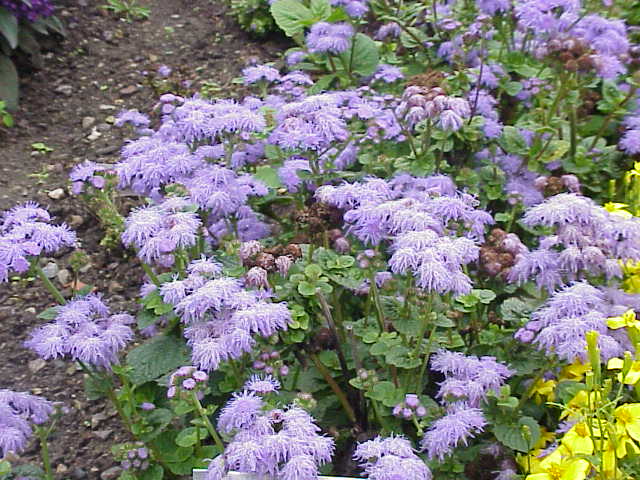- Eupatorieae
Taxobox
name = Eupatorieae

image_caption = "Ageratum houstonianum"
regnum =Plant ae
divisio =Angiospermae
unranked_classis =eudicot
ordo =Asterales
familia =Asteraceae
tribus = Eupatorieae
tribus_authority = Cass. 1819
subdivision_ranks = Genera
subdivision = About 170–180; see text for a longer list.
"Ageratina " "Ageratum " "Bartlettina "
"Brickellia " "Chromolaena " "Conoclinium " "Critonia " "Eupatorium " "Eutrochium " "Fleischmannia " "Hebeclinium " "Koanophyllon " "Liatris " "Mikania " "Stevia " "Stomatanthes " and othersEupatorieae is a tribe of over 2000 species of plants in the aster family. The tribe includes both
Northern Hemisphere andSouthern Hemisphere plants. Well-known members are "Stevia rebaudiana" (known for its sweet leaves), a number ofmedicinal plant s (for example in "Eupatorium "), and a variety of late summer to autumn blooming garden flowers, including "Ageratum " and "Conoclinium " (mistflower).Plants in this tribe have only
disc floret s (noray floret s) and petals which are white, slightly yellowish off-white, pink, or purple (never a full yellow).cite web | url = http://www.efloras.org/florataxon.aspx?flora_id=1&taxon_id=20539 | title = 187n. Asteraceae tribe Eupatorieae | work = Flora of North America (Vol. 21 Page 456, 459) | accessdate = 2007-10-06 ] [cite web | url = http://flora.huh.harvard.edu/china/mss/volume21/Asteraceae-AGH-Eupatorieae_edited.htm | title = Asteraceae Tribe EUPATORIEAE (draft) | accessdate = 2007-10-06 ]Within the aster family, the Eupatorieae are nested within what has traditionally been the
Heliantheae (broadly defined). Because this leads to aparaphyletic Heliantheae, various authors have proposed either making the Eupatorieae a subtribe within the Heliantheae, or breaking the Heliantheae into a dozen or so tribes.Genera
There are approximately 170 to 180 [Mabberley. "The Plant Book".] genera in the Eupatorieae. The following list is incomplete:
:"
Acanthostyles " - "Adenostemma " - "Ageratina " - "Ageratum " - "Agrianthus " - "Amboroa " - "Aristeguietia " - "Ascidiogyne " - "Asplundianthus " - "Austroeupatorium " - "Ayapana " - "Ayapanopsis " - "Badilloa " - "Bartlettina " - "Brickellia " - "Brickelliastrum " - "Campuloclinium " - "Carminatia " - "Carphephorus " - "Carphochaete " - "Chromolaena " - "Condylidium " - "Conoclinium " - "Critonia " - "Critoniella " - "Cronquistianthus " - "Crossothamnus " - "Dasycondylus " - "Decachaeta " - "Ellenbergia " - "Eupatorium " - "Eutrochium " - "Ferreyrella " - "Fleischmannia " - "Fleischmanniopsis " - "Flyriella " - "Grosvenoria " - "Guevaria " - "Gymnocoronis " - "Hatschbachiella " - "Hebeclinium " - "Helogyne " - "Heterocondylus " - "Hughesia " - "Idiothamnus " - "Isocarpha " - "Kaunia " - "Koanophyllon " - "Lasiolaena " - "Liatris " - "Mikania " - "Neocabreria " - "Neocuatrecasia " - "Neomirandea " - "Nothobaccharis " - "Ophryosporus " - "Phalacraea " - "Piqueria " - "Pleurocoronis " - "Polyanthina " - "Praxelis " - "Raulinoreitzia " - "Santosia " - "Sciadocephala " - "Sclerolepis " - "Shinnersia " - "Stevia " - "Stomatanthes " - "Stylotrichium " - "Tamaulipa " - "Trilisa " - "Trichogonia " - "Uleophytum " - "Urolepis "Sources: cite journal | title = Phylogeny and biogeography of Eupatorium (Asteraceae: Eupatorieae) based on nuclear ITS sequence data | author = Gregory J. Schmidt and Edward E. Schilling | journal = American Journal of Botany | year = 2000 | volume = 87 | pages = 716–726 | url = http://www.amjbot.org/cgi/content/full/87/5/716 | pmid = 10811796 | doi = 10.2307/2656858 ] [ [http://plants.usda.gov/ PLANTS] ] cite journal | title = Comments on the Generic Concepts in the Eupatorieae | author = H. Robinson, R. M. King | journal = Taxon | volume = 34 | issue = 1 | date = February 1985 | pages = 11–16 | doi = 10.2307/1221557]Classification
Although the genus "
Eupatorium " has at times contained as many as a third of the species in the tribe, [cite journal | title = The Sectional Nomenclature of Eupatorium (Asteraceae) | author = Alan Whittemore | journal = Taxon | volume = 36 | issue = 3 | date = August 1987 | pages = 618–620 | doi = 10.2307/1221856 ] all but a few dozen of its species have been gradually moved into other genera.A partial phylogeny of the tribe (focusing on "
Eupatorium " and some of the other North American genera) is:clade | style=font-size:75%;line-height:75%
1=clade
1="Mikania "
2="Ageratina "
2=clade
1="Brickellia "
2=clade
1=clade
1=clade
1="Chromolaena "
2="Stomatanthes "
2=clade
1="Fleischmannia "
2=clade
1="Ageratum "
2="Conoclinium " (mistflower)
2=clade
label1=subtribe Liatrinae
1=clade
1="Trilisa "
2="Carphephorus "
3="Liatris "
2=clade
1="Eutrochium " (Joe-Pyes)
2="Eupatorium "Although the division of the tribe into subtribes is still not clear (with some past divisions not being supported by molecular data), several subtribes not covered above are:
*Gyptidinae, found mostly in eastern Brazil. "
Agrianthus ", "Campuloclinium ", "Lasiolaena ", and "Trichogonia ".
*Critoniinae. "Critonia ", "Fleischmanniopsis ", "Ophryosporus ", and "Neocabreria ".References
External links
*cite journal | title = Geographical distribution of Eupatorieae (Asteraceae) in South-eastern and South Brazilian Mountain Ranges | journal = Plant Ecology | issn = 1573-5052 | volume = 174 | issue = 1 | date = May, 2004 | doi = 10.1023/B:VEGE.0000046061.41915.d9 | pages = 163–181 | author = Almeida, Adriana M.
*cite journal | title = Chromosome Numbers in Compositae, XVI: Eupatorieae II | author = Harold Robinson, A. Michael Powell, Gerald D. Carr, Robert M. King, James F. Weedin | journal = Annals of the Missouri Botanical Garden | volume = 76 | issue = 4 | date = 1989 | pages = 1004–1011 | doi = 10.2307/2399689
*cite journal
last =Cassini
first =Alexandre de
authorlink =Alexandre de Cassini
title = unknown
journal =Journal de Physique, de Chimie et d'Histoire Naturelle
volume = 88
pages =196
location =Paris
date =1794-1823
url =http://www.archive.org/details/journaldephysiqu88pari
id =J. Phys. Chim. Hist. Nat. Arts
accessdate = 2008-06-30
Wikimedia Foundation. 2010.
